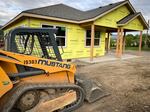
A home in Talent, Oregon, that was destroyed in the Almeda Fire on Sept. 8, 2020, is nearing completion as of early May 2021.
April Erlich / JPR
The costs of construction materials are at all-time highs, which is making it difficult for Oregonians to rebuild after last year’s wildfires.
Lumber prices have tripled this past year, adding tens of thousands of dollars to building a home.
That’s preventing some Oregonians from rebuilding their homes that were destroyed by last year’s wildfires.
“We don’t have enough money to rebuild the exterior, so we are not rebuilding, most likely,” says Meghan Hays of Phoenix, who lost her townhome to the Almeda Fire. “If materials didn’t go up 300 percent, we would be able to rebuild.”
Hays wasn’t able to get federal disaster assistance through a grant or a loan. She says her insurance coverage isn’t nearly enough.
And she’s not alone.
“Many of these people, depending on the coverage that they bought with their insurance carriers, may find that their coverage is insufficient to build under our current economic circumstances,” says Brad Bennington of the Builders Association of Southern Oregon.
The costs of construction materials have increased across the board — including windows, sheetrock, roofing, and even parts that are needed to build machines such as excavators.
Bennington says market interruptions from the pandemic are mostly to blame. Many companies dialed back manufacturing and production early on, then they haven’t been able to return to their previous staffing levels.
“On the lumber side, there was this general idea that, ‘Well, when this thing gets fired up again, when the market starts getting going again, it’ll take us a while to get back to normal, but we’ll do it,’” Bennington says. “That’s not what happened. That’s not what happened at all.”
He adds that Southern Oregon has also endured a shortage of construction workers since the 2008 Great Recession, when markets collapsed and construction demand dropped.
There is some hope on the horizon: Lumber production has recently ramped up, so prices should ease in a few months.